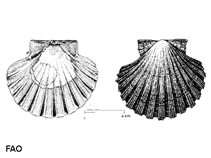Pecten jacobaeus (Linnaeus, 1758)
Great mediterranean scallop| Native range | All suitable habitat | Point map | Year 2050 |

|
| This map was computer-generated and has not yet been reviewed. |
| Pecten jacobaeus AquaMaps Data sources: GBIF OBIS |
Classification / Names Common names | Synonyms | CoL | ITIS | WoRMS
Bivalvia | Pectinida | Pectinidae
Environment: milieu / climate zone / depth range / distribution range Ecology
Benthic; depth range 0 - 500 m (Ref. 356), usually 0 - 30 m (Ref. 437). Subtropical, preferred 20°C (Ref. 107945); 45°N - 28°S, 29°W - 36°E
Distribution Countries | FAO areas | Ecosystems | Occurrences | Introductions
Eastern Atlantic and Mediterranean Sea: from Portugal to Canary Islands, Azores Island then east to Lebanon.
Length at first maturity / Size / Weight / Age
Maturity: Lm ?, range 5 - 6 cm Max length : 25.0 cm SHL male/unsexed; (Ref. 356); common length : 10.0 cm SHL male/unsexed; (Ref. 437)
Life cycle and mating behavior Maturity | Reproduction | Spawning | Eggs | Fecundity | Larvae
Life cycle: Embryos develop into free-swimming trocophore larvae, succeeded by the bivalve veliger, resembling a miniature clam (Ref. 833).
Main reference
References | Coordinator | Collaborators
SAUP Database. 2006. (Ref. 356)
IUCN Red List Status (Ref. 130435: Version 2024-1)
CITES status (Ref. 108899)
Not Evaluated
CMS (Ref. 116361)
Not Evaluated
Threat to humans
Human uses
Fisheries: commercial
FAO - Fisheries: landings | FishSource | Sea Around Us
Tools
More information
Trophic Ecology
Ecology
Population dynamics
Life cycle
Distribution
Human Related
Aquaculture profile
Stamps, Coins Misc.
Stamps, Coins Misc.
Outreach
Taxonomy
References
Internet sources
BHL | BOLD Systems | CISTI | DiscoverLife | FAO(Fisheries: ; publication : search) | Fishipedia | GenBank (genome, nucleotide) | GloBI | Gomexsi | Google Books | Google Scholar | Google | PubMed | Tree of Life | Wikipedia (Go, Search) | Zoological Record
Estimates based on models
Preferred temperature
(Ref. 115969): 15.9 - 21.6, mean 18.7 (based on 220 cells).
Prior r = 0.43, 95% CL = 0.29 - 0.65, Based on 1 full stock assessment.
Nutrients : Calcium = 149 [71, 228] mg/100g; Iron = 8.53 [1.95, 15.11] mg/100g; Protein = 9.88 [8.64, 11.12] %; Omega3 = 0.313 [0.202, 0.423] g/100g; Selenium = 61 [50, 72] μg/100g; VitaminA = 0 μg/100g; Zinc = 2.04 [0.56, 3.51] mg/100g (wet weight); based on nutrient studies.



